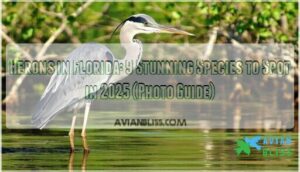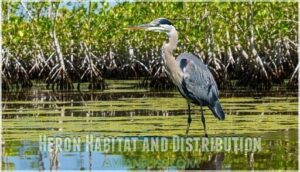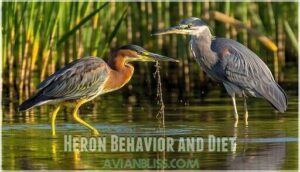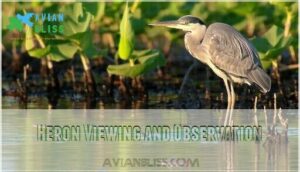This site is supported by our readers. We may earn a commission, at no cost to you, if you purchase through links.

These elegant birds wade through marshes, mangroves, and coastal areas, using their specialized bills to spear fish with lightning-fast precision.
Florida’s year-round warm climate makes it a perfect habitat for these birds, whether they’re permanent residents or seasonal visitors.
You’ll often spot them standing perfectly still at water’s edge, an indication of their incredible patience.
Next time you’re near Florida water, look for that distinctive S-curved neck and dagger-like bill—knowing which species you’ve spotted makes the experience even more rewarding.
Table Of Contents
- Key Takeaways
- Heron Species Overview
- Heron Habitat and Distribution
- Heron Behavior and Diet
- Heron Identification and Conservation
- Heron Viewing and Observation
- Frequently Asked Questions (FAQs)
- Can herons recognize individual human faces?
- How do herons react to extreme weather events?
- What are herons’ primary predators in Florida?
- How do herons interact with other bird species?
- Do herons migrate in groups or individually?
- How do herons build and maintain their nests?
- What predators threaten herons in Florida?
- How do juvenile herons differ from adults?
- What sounds do various heron species make?
- Can herons be kept as pets legally?
- Conclusion
Key Takeaways
- You’ll find nine diverse heron species in Florida’s wetlands, ranging from the towering Great Blue Heron (standing over 4 feet tall) to the compact Green Heron that’s known for using tools to attract fish.
- Florida’s year-round warm climate creates ideal habitats in freshwater marshes, coastal wetlands, and mangroves where you can spot herons displaying their distinctive S-curved necks and dagger-like bills.
- You’ll notice herons’ remarkable hunting techniques, including perfect stillness, lightning-fast strikes, and specialized feeding strategies – with some species like the Green Heron even using bait to lure prey.
- When observing herons, you’ll have the best viewing experiences during early morning or late afternoon at locations like Merritt Island National Wildlife Refuge, Wakodahatchee Wetlands, and Fort DeSoto Park, but remember to maintain respectful distance and quiet observation.
Heron Species Overview
You’ll find nine diverse heron species in Florida’s wetlands, from the majestic Great Blue Heron standing over 4 feet tall to the smaller Green Heron known for using tools to catch fish.
These water-loving birds can be spotted year-round in Florida’s freshwater marshes, coastal areas, and mangroves, where they hunt alone despite often nesting together in large colonies called heronries.
Nature’s patient hunters, Florida’s herons stand alone in the shallows but build their future together in bustling heronries.
Great Egret Characteristics
The Great Egret stands out as Florida’s elegant white sentinel.
You’ll recognize this large heron by its striking appearance and graceful movements along shorelines.
- Yellow bill shaped like a dagger for precise fish-striking
- Pure white plumage that seems to glow in morning light
- S-curved neck that folds into a distinctive "S" when flying
- Long black legs contrasting beautifully with white feathers
- Delicate aigrettes (special plumes) that extend during breeding season, featuring a striking appearance and graceful movements.
Great Blue Heron Features
While white egrets dazzle with their snowy plumage, the Great Blue Heron stands as Florida’s largest heron species.
You’ll spot these majestic birds by their distinctive slate-blue feathers, S-curved neck, and impressive size (36-54 inches tall with a 6-foot wingspan).
Look for their elegant black head crest, yellow bill, and their slow, deliberate flight pattern with necks folded in an S-shape.
When nesting, they build large platforms high in trees, utilizing their impressive size to construct a safe haven.
Green Heron Traits
While the Great Blue Heron towers over wetlands, the Green Heron offers a striking contrast in both size and behavior.
This compact heron species is one of Florida’s most fascinating residents, known for its remarkable tool use – drops bait to attract fish.
Some key characteristics of the Green Heron include:
- Glossy green-black crown and back with chestnut neck
- Master ambush predator that freezes perfectly still while hunting
- Inhabits freshwater marshes, ponds, and mangroves year-round
- Small heron measuring just 38-50 cm with distinctive hunched posture
Little Blue Heron Identification
While Green Herons are small and stocky, the Little Blue Heron offers a different identification challenge.
You’ll find these small herons common year-round in Florida, appearing in 21% of summer and 29% of winter checklists.
Their most distinctive feature? Juvenile plumage starts completely white before gradually molting to slate-blue.
This can cause confusion with Snowy Egrets, but look for their bluish-gray legs instead of black legs with yellow feet.
Tricolored Heron Distinctions
Identifying the Tricolored Heron isn’t difficult once you know its distinctive features.
You’ll spot this slender Florida heron by its bluish-gray body, white belly, and rusty-red neck stripe.
During breeding season, they develop striking white head plumes.
Unlike other heron species, Tricolored Herons have unique vocalizations—a soft "waah" sound—and display aggressive foraging ecology, often running after prey in shallow waters.
Juvenile markings show more brown plumage variations.
Heron Habitat and Distribution
You’ll find Florida’s herons in diverse wetland habitats, from freshwater marshes and swamps to coastal mangroves and saltwater shorelines.
These water-loving birds establish year-round residency throughout the state, making Florida an ideal location to observe all nine species regardless of when you visit.
Freshwater Habitats
Numerous Florida herons thrive in freshwater habitats throughout the state.
You’ll find these elegant birds wading through shallow marshes, ponds, and lake environments where they hunt for prey.
River habitats and inland waterways provide essential feeding grounds, while swamp habitats offer protected nesting sites.
Wetlands with abundant vegetation support diverse heron populations by maintaining healthy marsh ecology and pond ecosystems that sustain their preferred food sources.
Saltwater Habitats
After spotting herons in freshwater ponds and lakes, you’ll find these elegant birds thriving in Florida’s saltwater habitats too.
Herons display remarkable salinity tolerance, allowing them to forage along beaches, tidal flats, and salt marshes.
These marine ecosystems provide rich feeding grounds where you’ll observe species like the Great Blue Heron wading through shallow coastal areas, hunting for fish and crustaceans in the brackish waters of estuaries.
Coastal Wetlands and Mangroves
Coastal wetlands and mangroves serve as vital habitats for Florida herons, offering perfect feeding and nesting grounds.
These unique ecosystems provide:
- Natural storm protection for shorelines and heron colonies
- Varied salinity tolerance zones supporting diverse heron species
- Rich coastal foodwebs with abundant fish and crustaceans
- Critical mangrove nesting sites protected from predators
Unfortunately, these areas face significant habitat loss due to coastal development, threatening the delicate balance that supports these majestic wading birds.
Year-Round Residency in Florida
Florida’s devoted heron species maintain year-round residency across the state, with Great Egrets and Great Blue Herons showing stable population stability.
You’ll find these resilient birds adapting their nesting habits to seasonal changes without migrating.
While Tricolored Herons remain at "Least Concern" conservation status, smaller Egretta heron species face declining numbers.
Climate impact affects resource availability, but the Great Blue Heron population continues increasing, ensuring Florida herons remain a constant in the avian population.
Notably, the Great Blue Heron also plays an impressive role in heron conservation.
Heron Behavior and Diet
You’ll notice Florida’s herons display fascinating hunting behaviors, from the Green Heron’s clever use of bait to attract fish to the Great Blue Heron’s patient stalking technique.
Their varied diets include fish, frogs, small mammals, crustaceans, and insects, with each species developing specialized feeding strategies for their preferred habitats.
Feeding Patterns and Strategies
Patience defines the feeding patterns of Florida’s herons.
You’ll observe these birds standing motionless in shallow water, waiting for prey to come within striking distance. Their foraging habitats range from marshes to mangroves, with each species showing unique dietary adaptations.
Most herons practice stealthy hunting, striking with lightning-fast precision when fish, frogs, or crustaceans appear.
Seasonal diet shifts occur as prey availability changes throughout the year, which can be influenced by prey availability.
Ambush Predation and Tool Use
During quiet moments at the water’s edge, you’ll witness herons displaying remarkable hunting techniques that have evolved over millennia.
These stealthy hunters use sophisticated ambush predation and even tools to capture prey. The herons’ diet consists of fish, frogs, and aquatic insects, but they’re also known to consume small mammals and reptiles.
Five fascinating heron hunting behaviors:
- Green Herons dropping bait objects to attract fish
- Motionless waiting in shallow water for unsuspecting prey
- Neck coiling for lightning-fast strikes
- Adaptive behavior changing based on prey movement
- Tool use showing remarkable problem-solving abilities
The herons’ ability to adapt and use sophisticated ambush predation makes them efficient hunters, and their diet is a testament to their diverse feeding habits.
Fish and Invertebrate Consumption
If you’ve ever watched a heron hunting, you’ll notice their impressive patience. These birds primarily consume fish, making up about 75% of their diet.
You’ll see them stalking shallow waters for minnows, sunfish, and catfish. Their stealthy hunting techniques also target crayfish, shrimp, and aquatic insects.
During seasonal diet shifts, some species adapt their prey selection based on availability, demonstrating remarkable flexibility in their feeding habits and foraging strategies.
Small Mammal and Bird Predation
Beyond fish, herons have surprisingly diverse diets.
Beyond fish, herons reveal their versatility as predators – surprising even seasoned birdwatchers with their diverse hunting strategies.
You’ll find Great Blue Herons capturing small mammals like shrews, rats, and squirrels with their dagger-like bills. These patient hunters don’t stop there—they’ll also raid nests for birds.
Herons in Florida use varied hunting techniques, from standing motionless to stalking through shallow waters. Their predation impact can substantially affect local populations, sometimes reducing numbers of both mammal and avian prey, which is a significant aspect of their role in the ecosystem with a considerable local impact.
Heron Identification and Conservation
You’ll learn to identify Florida’s nine heron species by their distinctive features and understand how your observations can help protect these birds for future generations.
Your knowledge of visual markers, flight patterns, and conservation efforts will make you an important ally in monitoring the health of Florida’s wetland ecosystems.
Visual Markers and Flight Patterns
While herons feed in fascinating ways, telling them apart requires keen observation of their visual markers and flight patterns.
You’ll notice Florida’s herons display distinctive plumage variation – from the slate-blue of Great Blue Herons to the pure white of Great Egrets.
Watch for their unique postures when hunting and their wing shape in flight. Little Blue Herons fly with steady, measured wing beats, while larger species demonstrate impressive soaring techniques across wetlands.
Accurate identification relies on detailed species information, which is crucial for understanding these unique creatures.
Threats to Heron Populations
While identifying herons by their flight patterns, you may notice fewer birds in some areas.
Florida’s herons face serious threats, with habitat loss topping the list. Development along shorelines destroys nesting sites, while pollution impacts their food sources.
Human disturbance at breeding grounds, climate change, and reduced prey abundance all contribute to declining populations.
Car strikes affect Great Blue Herons particularly, highlighting the need for wildlife preservation efforts.
Habitat restoration can substantially contribute to endangered bird recovery through conservation.
Protection Laws and Regulations
While habitat loss threatens these elegant birds, strong legal shields protect Florida’s herons.
All species receive federal protection under the Migratory Bird Treaty Act, making it illegal to harm them or disturb their nests.
Florida’s state wildlife laws add another layer of protection, prohibiting harassment of herons and modification of their habitats.
The Tricolored Heron gets special attention under Florida’s Endangered and Threatened Species Rule, highlighting its vulnerable status in wetland ecosystems.
Conservation Efforts in Florida
While Florida’s protection laws form a shield, on-the-ground conservation efforts are making real progress for herons.
Florida’s conservation plan focuses on:
- Habitat preservation across freshwater marshes and coastal wetlands
- Nesting protection for 15 species, including threatened tricolored and little blue herons
- Wetland restoration projects along the Gulf Coast
- Public awareness programs to reduce pollution in heron habitats
Groups like Audubon actively manage nesting colonies, ensuring these iconic birds remain a defining characteristic of Florida’s ecosystem.
The Great Blue Heron has a wingspan up to 79 inches.
Heron Viewing and Observation
You’ll find Florida’s diverse heron species in freshwater marshes, coastal wetlands, and mangrove habitats where these elegant birds display their unique feeding behaviors.
When you visit these locations during early morning or late afternoon hours, you can watch herons hunt fish, frogs, and small crustaceans using their remarkable patience and precision.
Best Locations in Florida
Numerous coastal hotspots offer prime viewing of herons in Florida.
You’ll find remarkable heron colonies at Merritt Island National Wildlife Refuge near Titusville, where tri-colored, great blue, and little blue herons gather.
Wakodahatchee Wetlands in Delray Beach provides up-close observation of nesting birds.
For inland sanctuaries, explore Black Point Wildlife Drive.
Fort DeSoto Park in Pinellas County and Caladesi Island State Park shelter diverse wetlands and coastal areas where these elegant birds thrive.
To plan your trip, consider using Florida birding maps to find the best birding spots and enjoy watching elegant birds.
Seasonal Variations and Migration
Tracking heron migration patterns can transform your birdwatching experience in Florida.
While some herons are year-round residents, others follow seasonal variations.
Great Blue Herons typically migrate south by September and October, traveling in groups from a few to 100 birds.
You’ll notice checklist variations between seasons, with some species wandering north in late summer before returning to winter habitats in Florida’s protective wetlands.
Viewing Etiquette and Guidelines
Six essential guidelines help you enjoy herons in Florida while respecting wildlife. Keep a suitable distance to avoid causing stress, especially near nesting birds.
You’ll capture better photos and protect these stunning creatures. Some herons, like the Great Blue Heron, are solitary wetland hunters.
- Use telephoto lenses for minimal disturbance while birdwatching
- Reduce noise by speaking quietly and avoiding sudden movements
- Follow designated paths to preserve natural habitats
- Approach slowly and wear neutral colors to blend with surroundings
Tips for Spotting Rare Heron Species
Now that you understand proper viewing behavior, let’s find those elusive birds.
To spot rare heron species in Florida, visit diverse habitats like freshwater marshes and coastal wetlands. Understanding coastal wetland mapping can further enhance your ability to locate these habitats.
Look for habitat clues and distinctive features such as wing spots on juvenile Black-crowned Night-Herons. Listen for unique vocalizations, especially at dawn or dusk when many species are active.
Join expert guides at regional hotspots to improve your heron identification skills.
Frequently Asked Questions (FAQs)
Can herons recognize individual human faces?
Sharp as tacks, herons likely can recognize you.
While specific heron studies aren’t available, research shows many birds identify human faces and remember their interactions with specific people.
You’ll find they’re watching and remembering.
How do herons react to extreme weather events?
You’ll notice herons may disperse during hurricanes and severe storms.
Some wading birds benefit from weather disturbances, while others gather in groups.
They’ve adapted over time to recover from major weather events, and severe storms are part of this adaptation.
What are herons’ primary predators in Florida?
Ever wonder what threatens these graceful birds?
You’ll find that herons face predation primarily from ravens, raccoons, vultures, and red-tailed hawks that target their eggs and nestlings.
Adult herons have few natural predators.
How do herons interact with other bird species?
You’ll find herons often coexist peacefully with other wading birds at feeding grounds, though they’ll defend their personal space.
They’re sometimes seen in mixed-species rookeries where they nest alongside egrets, ibises, and spoonbills.
Do herons migrate in groups or individually?
Herons typically migrate individually rather than in groups.
You’ll observe them flying solo during their seasonal movements, though they may gather at stopover sites where food is abundant during migration periods.
How do herons build and maintain their nests?
You’d think they’d be messy builders, but herons actually weave sticks and twigs into platform nests high in trees. They’ll maintain these structures throughout breeding season, adding materials as needed.
What predators threaten herons in Florida?
You’ll find these elegant birds face threats from predators and environmental factors.
Land development destroys habitats, while pesticides weaken their populations.
Parasites can cause infections, and various predators target eggs and nestlings, which are significant threats to these birds, making habitat preservation crucial.
How do juvenile herons differ from adults?
Like butterflies in metamorphosis, juvenile herons often display different plumage than adults.
You’ll notice many have duller colors or completely different patterns.
Little Blue Heron babies start white before gradually turning blue-gray.
What sounds do various heron species make?
You’ll notice Great Blue Herons squawk "roh-roh-rohs" when landing.
Green Herons give a harsh "skeow" call, a distinctive wetland sound.
Also, listen for their sharp "keow!" call when they take flight.
Can herons be kept as pets legally?
No, you can’t legally keep herons as pets.
They’re protected by wildlife laws, and you’d need special permits that aren’t issued for personal pets in Florida.
Wild birds deserve their freedom.
Conclusion
Like sentinels of the wetlands, herons in Florida stand as living treasures waiting for your discovery.
You’ll find these graceful birds throughout the state’s diverse aquatic habitats, each species offering its own unique charm.
Whether you’re a seasoned birder or casual observer, watching these patient hunters is truly mesmerizing.
Remember to maintain a respectful distance and bring binoculars for the best viewing experience. Florida’s herons will reward your patience with memories that last a lifetime.







